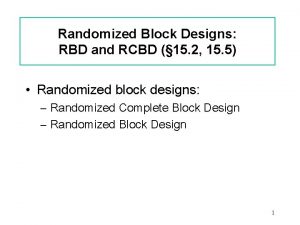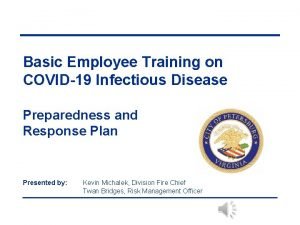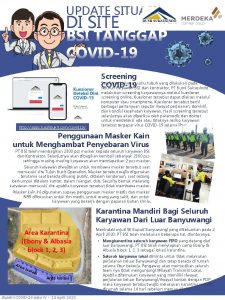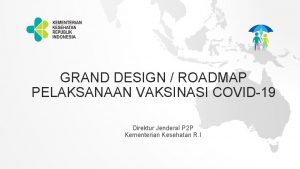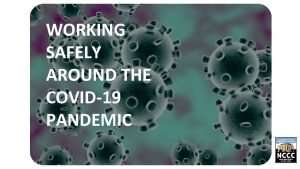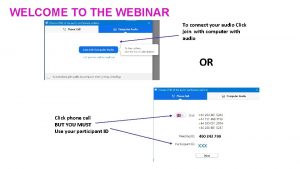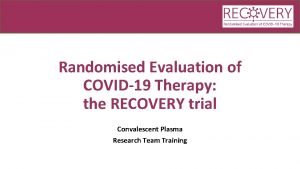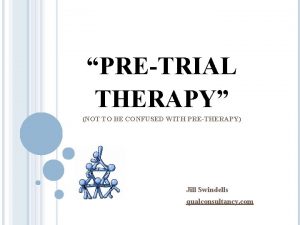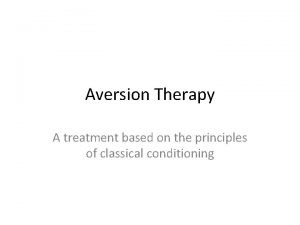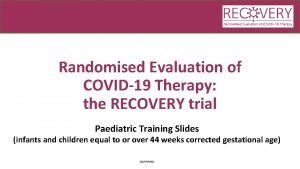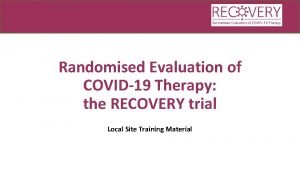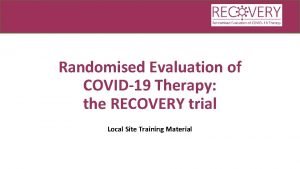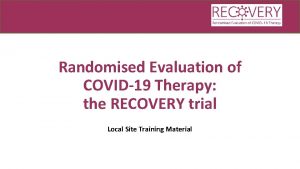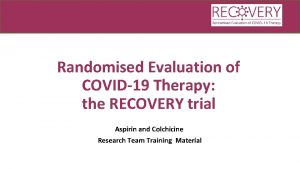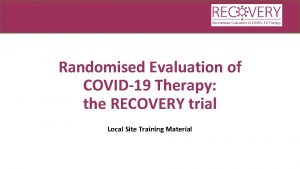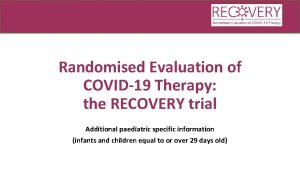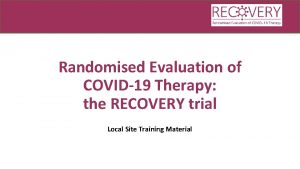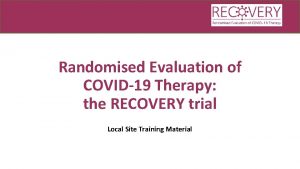Randomised Evaluation of COVID19 Therapy the RECOVERY trial













- Slides: 13

Randomised Evaluation of COVID-19 Therapy: the RECOVERY trial Convalescent Plasma Research Team Training

Trial design Lopinavir-ritonavir 400/100 mg bd PO for 10 days R Tocilizumab Dexamethasone 6 mg od PO/IV for 10 days Hydroxychloroquine See protocol for dosing Azithromycin 500 mg od PO/IV for 10 days R 2 No additional treatment OUTCOMES ELIGIBLE PATIENTS No additional treatment

Convalescent Plasma 1 unit on day 1 & 2 Tocilizumab R R 2 No additional treatment OUTCOMES ELIGIBLE PATIENTS Adding convalescent plasma in factorial design

R SOC + CP SOC - CP LOP + CP LOP - CP Tocilizumab DEX + CP DEX - CP HCQ + CP HCQ - CP AZM + CP AZM - CP CP vs No CP R 2 No additional treatment OUTCOMES ELIGIBLE PATIENTS Adding convalescent plasma in factorial design

Convalescent plasma • Convalescent plasma COVID-19 FFP (CP) is plasma donated from patients who have recovered from COVID-19 and contains antibodies which may neutralise SARS-Co. V-2 virus. • Some low quality data to suggest it may be effective in viral pneumonia • Need robust data from larger RCTs so has been included in RECOVERY and REMAP-CAP protocols

Consent and Randomisation • RECOVERY PIS+ICF V 5. 0 has information on CP and extra line on consent form: • Randomisation form has questions on: • Participant’s willingness to receive CP (i. e. the answer above) • Participant’s suitability for CP • Availability of CP

Allocation and access to CP • Allocations will be displayed: • BEFORE convalescent plasma can be supplied by transfusion lab: • Two Group & Screen samples must have been sent to laboratory (taken at separate times) • BEFORE administering convalescent plasma: • Assess for potential transfusion associated circulatory overload

Potential hazards of CP • Antibody-dependent enhancement • Theoretically antibodies may promote viral entry into cells and accelerate disease • No clear evidence of this in humans • Transfusion-associated circulatory overload (TACO) • Assess patient’s volume status and risk of circulatory overload before prescribing CP • Hypersensitivity reaction to plasma

Transfusion-associated circulatory overload • Most important cause of morbidity with transfusions • Consider: • Cardiac status • Pulmonary risk • Fluid balance • Actions could include: • Delay CP transfusion • Give at slower rate • Give with diuretic TACO checklist: available on study website

Prescription of CP • Adult dose: One unit (275 ± 75 m. L) on days 1 and 2 • At least 12 hours apart • Paediatric dose = 5 m. L/kg • See protocol for neonatal details • Administer as soon as possible and within 4 hours of defrosting if at room temperature or up to 24 hours if refrigerated between 2 - 6 o. C

Administration of CP • All standard administration checks as per local policy should be completed and documented • If any adverse reactions are suspected, inform: • Managing medical team • Transfusion laboratory/practitioner who will complete Serious Hazard of Transfusion (SHOT) reporting as required • If with first unit, re-consider before giving second unit • Document in medical records

Additional early safety data collection for first 200 CP recipients/controls • In first 72 hours after randomisation, has the participant had: • • • Sudden worsening in respiratory status Severe allergic reaction Temperature >39 o. C or ≥ 2 o. C rise above baseline Sudden hypotension (defined as either (i) sudden drop in systolic blood pressure of ≥ 30 mm. Hg with systolic blood pressure ≤ 80 mm. Hg; or (ii) requiring urgent medical attention) Clinical haemolysis (defined as fall in haemoglobin plus one or more of the following: rise in lactate dehydrogenase (LDH), rise in bilirubin, positive direct antiglobulin test (DAT), or positive crossmatch) • How many units of CP were given and were any stopped early • This information will be collected on additional Open. Clinica form • Standard SHOT reporting will also be used for all participants receiving CP

Summary • Convalescent plasma (CP) is being offered in a factorial randomisation at entry into RECOVERY • Participant may opt out of this part of the trial but still participate in the rest • Ensure all participants are considered for the risk of transfusion-associated circulatory overload (TACO) before administering CP • CP should be given according to local policy for blood products • First 200 participants in this randomisation will have extra safety information collected
 Crd rcbd
Crd rcbd Difference between rbd and rcbd
Difference between rbd and rcbd What do if test positive covid19
What do if test positive covid19 Http://apps.tujuhbukit.com/covid19/
Http://apps.tujuhbukit.com/covid19/ Vaksin covid19
Vaksin covid19 Do if you covid19
Do if you covid19 Covid19 athome rapid what know
Covid19 athome rapid what know Recovery trial training
Recovery trial training Pre trial therapy training
Pre trial therapy training Both psychoanalysis and humanistic therapy stress
Both psychoanalysis and humanistic therapy stress Bioness bits cost
Bioness bits cost What are the major humanistic therapies
What are the major humanistic therapies Lewisville speech therapy evaluation
Lewisville speech therapy evaluation Evaluation of aversion therapy
Evaluation of aversion therapy

